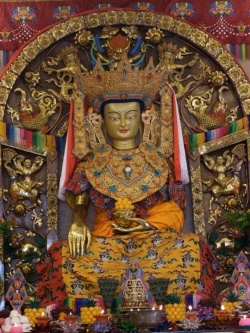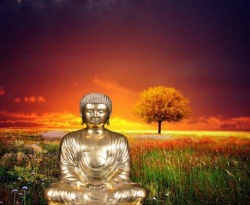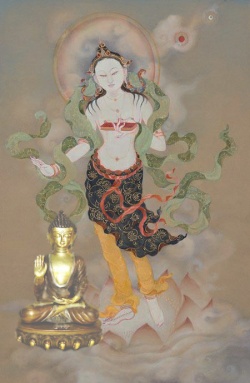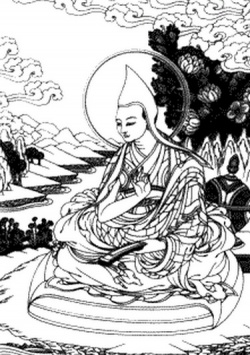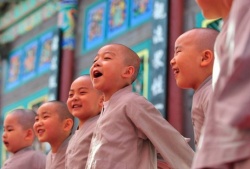Vima Nyingtik Explained
Vima Nyingtik Explained
Vima Nyingthig or "Vimalamitra's Seminal Heart" (Tibetan: བི་མ་སྙིང་ཐིག་; Wylie: bi ma snying thig) is a practice lineage of Mantrayana.
It is one of the nyingthig or seminal heart teachings of the Mennagde cycle of Dzogchen and was codified and collated by Longchenpa (1308–1364?) in the fourteenth century.
The Mennagde all convey teachings and practices on Trekcho in a largely comparable manner but it is in their presentation of Togal that they greatly differ.
The Vima Nyingtik itself consists of tantras (rgyud), agamas (lung), and upadeshas (man ngag).[1] The tantras here refer to the Seventeen Tantras. Namkhai(1991) & Vajranatha (1996: p.18) hold that agamas that pertain to the Vima Nyingtik were compiled by Vimalamitra (fl. 8th century) and are known as the "five series" (W: sde tshan lnga),
are the "Golden Letters"
(W: gser yig can),
the "Turquoise Letters" (W: gyu yig can),
the "Copper Letters" (W: zangs yig can),
the "Conch Shell Letters" (dung yig can) and
the "Variagated Letters" (phra yig can).[2]
The upadeshas of the Vima Nyingtik refer to 119 treatises of pith advice.
The Vima Nyingthig is founded principally on the "Seventeen Tantras" and the "Troma Tantra".[3]
The Vima Nyingthig denotes the teachings both for and of the scholars or pandita, brought to Tibet by Vimalamitra.[3]
Troma Tantra
The "Troma Tantra" or the "Ngagsung Tromay Tantra" otherwise known as the "Ekajaṭĭ Khros Ma'i rGyud" focuses on rites of the protector, Ekajati.[4]
Seventeen tantras
The "Seventeen tantras of the esoteric instruction cycle" which are supports for the Vima Nyingthig are as follows (in no particular order):
"Self-existing Perfection"
"Without Letters"
"Self-arising Primordial Awareness"
"Self-liberated Primordial Awareness"
"Piled Gems"
"Shining Relics of Enlightened Body"
"Reverberation of Sound"
"Great Auspicious Beauty"
"The Mirror of the Heart of Vajrasattva"
"The Mirror of the Mind of Samantabhadra"
"Direct Introduction"
"Necklace of Precious Pearls"
"Sixfold Expanse of Samantabhadra"
"Blazing Lamp"
"Union of the Sun and Moon"
"Lion's Perfect Expressive Power"
"Array of Jewels"
These Seventeen Tantras are to be found in the Canon of the Ancient School, the Nyingma Gyubum, volumes 9 and 10, folio numbers 143–159 of the edition edited by Jamyang Khyentse Rinpoche commonly known as Dilgo Khyentse Rinpoche (Thimpu, Bhutan, 1973), reproduced from the manuscript preserved at Tingkye Gonpa Jang Monastery in Tibet.
Lineage
Kumaradza was a senior disciple of Melong Dorje (1243–1303).
Kumaradza studied with the grand master Orgyenpa (1230–1309), who conveyed teachings of "Vimalamitra's Seminal Heart" (Tibetan: བི་མ་སྙིང་ཐིག་; Wylie: bi ma snying thig) upon him.
Testaments of the knowledge-holders
"The Posthumous Teachings of the Vidyadhara" are found in the Vima Nyingtik. These are the last testaments of the early vidyadharas: Garab Dorje, Manjushrimitra, Shri Singha and Jnanasutra.
These testaments are post-humous as they were delivered by the vidhyadhara to their senior disciple from within a thigle of the Five Pure Lights in their Rainbow Body of Light.
In this tradition, the thigle is understood to be comparable to a pure dimension or mandala. These were first compiled by Vimalamitra in his five series (which consisted of the series of: Golden Letters, Copper Letters, Variegated Letters, Conch Shell Letters and Turquoise Letters).
These posthumous teaching belong to the series of the "Golden Letters" .
Last testament of Garab Dorje
"The Three Statement That Strike the Essential Points" or "The Three Vajra Verses"
Last testament of Manjushrimitra
"The Six Meditation Experiences"
Last testament of Shri Singha
"The Seven Nails"
Last testament of Jnanasutra
"The Four Methods of Establishing Absorption"
Vima Nyingtik: Fourth Volume
The Eleven Themes
Scheidegger (2009: p.43) in a recent work discusses the first four of "The Eleven Themes" a work composed by Longchenpa contained in the fourth volume of the Vima Nyingtik.[5]
References
Rigpa Shedra (August, 2009). "Vima Nyingtik". Source: http://www.rigpawiki.org/index.php?title=Vima_Nyingtik (accessed: Saturday October 17, 2009)
Namkhai, Norbu (1991, author) & Vajranatha (1996, translator). "Forward" in Vajranatha (1996). The Golden Letters. First Edition. Ithaca, New York, USA: Snow Lion Publications. ISBN 1559390506, p.18
Thondup, Tulku & Harold Talbott (Editor)(1996). Masters of Meditation and Miracles: Lives of the Great Buddhist Masters of India and Tibet. Boston, Massachusetts, USA: Shambhala, South Asia Editions. ISBN 1-57062-113-6 (alk. paper); ISBN 1-56957-134-1, p.33
Thondup, Tulku & Harold Talbott (Editor)(1996). Masters of Meditation and Miracles: Lives of the Great Buddhist Masters of India and Tibet. Boston, Massachusetts, USA: Shambhala, South Asia Editions. ISBN 1-57062-113-6 (alk. paper); ISBN 1-56957-134-1, p.362
Scheidegger, Daniel (2009). "The First Four Themes of Klong chen pa's Tsig don bcu gcig pa". Achard, Jean-Luke (director) (2009). Revue d'Etudes Tibetaines. April 2009. Source: http://himalaya.socanth.cam.ac.uk/collections/journals/ret/pdf/ret_16.pdf (accessed: Saturday October 31, 2009)
